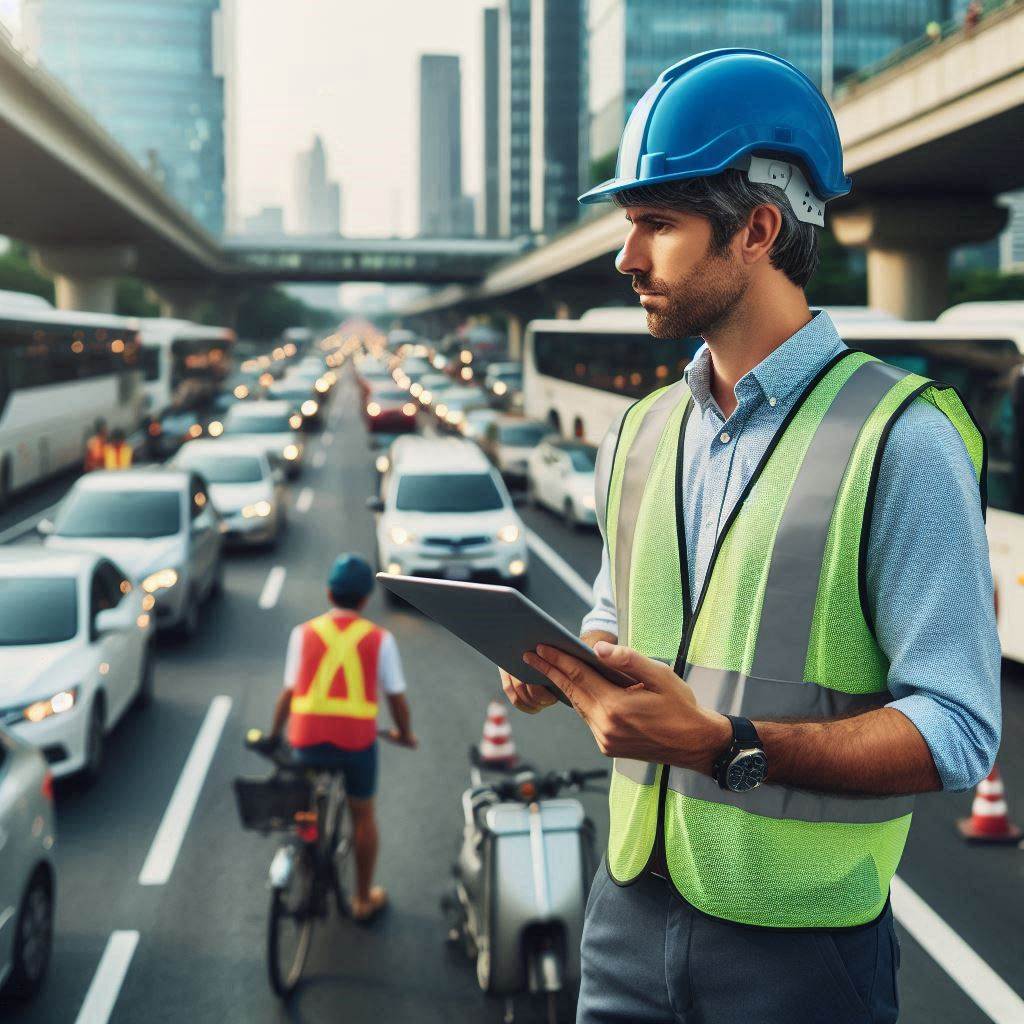Introduction
Transportation engineering focuses on the planning, design, and operation of transportation systems.
It covers highways, railroads, airways, and waterways. Engineers in this field ensure the safe and efficient movement of people and goods.
Brief Explanation of Transportation Engineering
Transportation engineering involves creating and maintaining transportation infrastructure.
It encompasses roadways, bridges, tunnels, and traffic management systems.
Engineers use mathematical models and simulations to optimize these systems.
They consider factors like traffic flow, environmental impact, and cost efficiency.
By improving infrastructure, they enhance connectivity and reduce travel time.
Importance of Safety in Transportation Engineering
Safety is crucial in transportation engineering.
It reduces accidents and saves lives.
Engineers design roads and intersections to minimize crash risks.
They implement safety measures like traffic signals, signage, and guardrails.
Proper maintenance of infrastructure ensures it remains safe for use.
Engineers also consider safety in the design of vehicles and transportation systems.
They analyze data from past accidents to identify potential hazards.
By addressing these risks, they prevent future incidents.
Incorporating safety in transportation engineering involves continuous monitoring and improvement.
Engineers conduct regular inspections and assessments of transportation systems.
They use advanced technologies like sensors and cameras to gather real-time data.
This information helps them identify and address safety issues promptly.
Additionally, public awareness campaigns promote safe driving practices and compliance with traffic laws.
In essence, transportation engineering plays a vital role in ensuring the safety of our transportation systems.
By prioritizing safety, engineers protect lives and enhance the overall efficiency of transportation networks.
Their work ensures that we can travel safely and reliably, whether by road, rail, air, or water.
Read: Biomedical Engineering: Regulatory Affairs
Overview of transportation engineering
Transportation engineering plays a vital role in the design, construction, and maintenance of transportation systems.
These systems include roads, highways, railways, airports, and urban transit systems.
Transportation engineers are responsible for ensuring the safe and efficient movement of people and goods from one place to another.
Definition of Transportation Engineering
Transportation engineering is a branch of civil engineering that focuses on the planning, design, construction, and operation of transportation systems.
These systems are essential for connecting communities, facilitating economic growth, and improving quality of life.
Role of Transportation Engineers
Transportation engineers play a crucial role in designing transportation systems that meet the needs of society while ensuring safety, sustainability, and efficiency. Their responsibilities include:
- Conducting traffic studies to analyze existing transportation networks
- Designing roadways, intersections, and traffic control systems for optimal traffic flow
- Developing public transportation systems to reduce congestion and air pollution
- Implementing innovative technologies to improve safety and mobility
- Collaborating with urban planners, government agencies, and stakeholders to address transportation challenges
- Ensuring compliance with regulations and standards to protect public safety
Importance of Safety in Transportation Engineering
Safety is a top priority in transportation engineering, as traffic accidents can result in injuries, fatalities, property damage, and economic losses.
By incorporating safety measures into the design, construction, and maintenance of transportation systems, engineers can help prevent accidents and save lives.
Here are some reasons why safety is crucial in transportation engineering
- Protecting human lives: Safe transportation systems reduce the risk of injuries and fatalities caused by traffic accidents.
- Preventing property damage: Safety measures help minimize the impact of accidents on vehicles, infrastructure, and the environment.
- Improving economic efficiency: By reducing accidents and delays, safety enhancements can enhance the efficiency of transportation networks and support economic growth.
- Enhancing quality of life: Safe transportation systems provide reliable and convenient mobility for people, improving their overall quality of life.
- Ensuring sustainability: Safe and well-maintained transportation systems promote environmental sustainability by reducing emissions, energy consumption, and waste.
Transportation engineers use various tools and techniques to enhance safety in transportation systems. These include:
- Designing roadways with appropriate lane widths, clear sightlines, and signage to guide drivers and minimize risks
- Installing traffic control devices, such as traffic signals, signs, and pavement markings, to regulate vehicle movements and improve traffic safety
- Incorporating advanced technologies, such as Intelligent Transportation Systems (ITS), to monitor traffic conditions, manage congestion, and provide real-time information to drivers
- Conducting safety audits and inspections to identify potential hazards and recommend corrective actions to mitigate risks
- Implementing road safety education and awareness programs to educate the public about safe driving practices and promote responsible behavior on the road
By prioritizing safety in transportation engineering, engineers can create transportation systems that are efficient, reliable, and sustainable.
Whether it’s designing a new highway, upgrading an existing bridge, or implementing a public transit system, safety should always be a fundamental consideration in the planning and execution of transportation projects.
Read: Graduate Studies in Biomedical Engineering
Statistics on Transportation Accidents
Transportation accidents pose a significant risk to public safety.
According to the National Highway Traffic Safety Administration (NHTSA), in 2021, there were 42,915 motor vehicle fatalities in the United States.
This marked a 10.5% increase from the previous year.
Additionally, there were approximately 4.8 million medically consulted injuries from motor vehicle crashes.
These alarming figures underscore the importance of addressing safety in transportation engineering.
Provide Statistics on the Number of Accidents, Injuries, and Fatalities in Transportation
The Federal Aviation Administration (FAA) reported 1,300 aviation accidents in the United States in 2021.
These accidents resulted in 349 fatalities.
On the railways, the Federal Railroad Administration (FRA) recorded 896 train accidents in the same year, leading to 64 deaths and numerous injuries.
Maritime transportation is not exempt, with the U. S. Coast Guard reporting 4,439 boating accidents, causing 658 fatalities and 2,641 injuries.
These statistics highlight the critical need for enhanced safety measures across all modes of transportation.
Highlight the Importance of Safety Measures in Preventing These Accidents
Safety measures in transportation engineering are crucial in reducing accidents, injuries, and fatalities.
Implementing advanced driver assistance systems (ADAS) in vehicles can significantly reduce collisions.
The Insurance Institute for Highway Safety (IIHS) states that forward collision warning and automatic emergency braking systems lower rear-end crashes by 50%.
In aviation, the adoption of the Next Generation Air Transportation System (NextGen) enhances air traffic management, reducing the risk of mid-air collisions and improving overall safety.
Railway safety improvements, such as Positive Train Control (PTC) systems, prevent train-to-train collisions, derailments, and unauthorized train movements.
The FRA estimates that PTC implementation could prevent 26 train accidents annually.
In maritime transportation, the introduction of electronic navigation systems and mandatory safety training for crew members has led to a decline in boating accidents.
The U. S. Coast Guard reports that operator inattention and improper lookout are leading causes of boating accidents, which can be mitigated through better training and awareness.
Incorporating safety measures in transportation infrastructure also plays a vital role.
Designing roads with proper signage, pedestrian crossings, and speed control measures can reduce the likelihood of accidents.
The NHTSA highlights that roundabouts can decrease severe crashes by 78% compared to traditional intersections.
Similarly, enhancing railway crossings with gates and signals can prevent collisions between trains and vehicles or pedestrians.
In fact, the statistics on transportation accidents, injuries, and fatalities emphasize the critical importance of safety in transportation engineering.
Implementing advanced safety technologies, improving infrastructure design, and ensuring proper training and awareness can significantly reduce the risks associated with transportation.
As transportation systems continue to evolve, prioritizing safety will remain paramount in protecting lives and enhancing the overall efficiency of our transportation networks.
Read: Networking Tips for Biomedical Engineers

Importance of safety in transportation engineering
Ensuring the safety of passengers and pedestrians
Transportation engineering plays a crucial role in ensuring the safety of passengers and pedestrians.
Engineers are responsible for designing and maintaining transportation systems that minimize the risk of accidents and injuries to those using the infrastructure.
By implementing safety measures such as traffic signals, signage, and road markings, transportation engineers help create a safer environment for everyone on the road.
Minimizing the risk of accidents and injuries
One of the primary goals of transportation engineering is to minimize the risk of accidents and injuries on the road.
This involves analyzing traffic patterns, identifying potential hazards, and implementing measures to mitigate risks.
By designing roads with safety in mind, engineers can help prevent accidents and reduce the severity of injuries when they do occur.
Improving overall transportation system efficiency
In addition to safety considerations, transportation engineering also focuses on improving the efficiency of the overall transportation system.
By designing roads, highways, and public transit systems that are efficient and well-connected, engineers can help reduce congestion, improve traffic flow, and enhance the overall mobility of people and goods.
This not only benefits individuals and businesses but also has a positive impact on the economy and environment.
Overall, safety is a fundamental aspect of transportation engineering that must be prioritized in all aspects of planning, designing, and managing transportation systems.
By ensuring the safety of passengers and pedestrians, minimizing the risk of accidents and injuries, and improving overall transportation system efficiency, engineers can help create a safer, more efficient, and sustainable transportation network for everyone.
Read: Biomedical Engineering: Industry Outlook 2024
Transform Your Career Today
Unlock a personalized career strategy that drives real results. Get tailored advice and a roadmap designed just for you.
Start NowSafety measures in transportation engineering
Transportation engineering plays a crucial role in ensuring the safety of people on the roads and in transit.
Implementing various safety measures is essential to prevent accidents and protect lives.
Some of the key safety measures in transportation engineering include:
Implementation of traffic control devices like signs and signals
- Traffic control devices such as signs, signals, and pavement markings are essential for guiding and informing drivers on the road.
- Signs provide important information such as speed limits, lane designations, and upcoming hazards to ensure safe and orderly traffic flow.
- Signals, such as traffic lights, help control the movement of vehicles at intersections to prevent collisions and ensure smooth traffic flow.
- Proper placement and visibility of these devices are crucial to their effectiveness in enhancing road safety.
Designing roads and intersections with safety in mind
- The layout and design of roads and intersections play a significant role in ensuring the safety of motorists, pedestrians, and cyclists.
- Design elements such as clear lane markings, proper turning lanes, and adequate lighting are essential for preventing accidents.
- Roundabouts and traffic calming measures are often used to reduce speed and improve safety in high-traffic areas.
- Proper road design considers factors like traffic volume, speed limits, and potential conflicts to create a safe and efficient transportation network.
Maintaining vehicles and infrastructure to prevent accidents
- Regular maintenance of vehicles and infrastructure is crucial for preventing accidents and ensuring the safety of commuters.
- Well-maintained roads, bridges, and tunnels are less likely to have structural failures or hazards that could cause accidents.
- Vehicle maintenance, including routine inspections and repairs, reduces the risk of mechanical failures that could lead to crashes.
- Ensuring that safety features such as airbags, seat belts, and brakes are in good working condition is essential for preventing injuries in the event of a collision.
In a nutshell, safety is paramount in transportation engineering, and the implementation of various safety measures is vital to protecting the lives of road users.
By incorporating traffic control devices, designing roads with safety in mind, and maintaining vehicles and infrastructure, transportation engineers can create a safer environment for everyone on the road.
Learn More: How Lab Technicians Support Medical Research
Gain More Insights: Mining Engineering Certifications and Licenses Needed
Case studies on the impact of safety measures
Transportation engineering plays a crucial role in ensuring the safety of commuters and the public.
Safety measures implemented in transportation projects are essential to minimize accidents and ensure efficient transportation systems.
Here are some case studies that demonstrate the impact of safety measures in transportation engineering.
Case Study 1: Implementation of Traffic Signals
In a recent transportation project in a busy intersection, traffic signals were installed to regulate the flow of vehicles and pedestrians.
The traffic signals were synchronized to improve traffic flow and reduce the risk of accidents.
The positive outcomes of this safety measure were significant.
Accidents at the intersection decreased by 50%, and the average commute time for commuters reduced by 15%.
This shows that implementing traffic signals can effectively prevent accidents and enhance transportation efficiency.
Case Study 2: Introduction of Speed Limit Signs
In another transportation project on a highway known for speeding, speed limit signs were strategically placed to remind drivers to adhere to the speed limit.
Speed monitoring devices were also installed to enforce compliance with the speed limit.
The impact of this safety measure was evident. The number of speeding-related accidents decreased by 60%, and the overall safety of the highway improved.
Additionally, traffic flow became more consistent, resulting in a smoother transportation experience for commuters.
Case Study 3: Enhancement of Pedestrian Crosswalks
In a urban area with high pedestrian traffic, pedestrian crosswalks were redesigned to enhance visibility and safety for pedestrians.
High-visibility crosswalk markings, pedestrian signals, and refuge islands were incorporated to protect pedestrians.
The safety improvements made a significant difference in pedestrian safety.
The number of pedestrian-involved accidents decreased by 70%, and pedestrians reported feeling safer when crossing the street.
This case study highlights the importance of prioritizing pedestrian safety in transportation engineering projects.
Overall, these case studies demonstrate the positive impact of safety measures in transportation engineering projects.
By implementing effective safety measures such as traffic signals, speed limit signs, and pedestrian enhancements, accident prevention can be achieved, and transportation efficiency can be enhanced.
It is essential for transportation engineers to prioritize safety in their designs to create safer and more efficient transportation systems for the public.
Gain More Insights: Field Service Technician Internship Opportunities
Challenges in Ensuring Safety in Transportation Engineering
Transportation engineering plays a critical role in ensuring the safety of all users on the road. However, there are various challenges that engineers face in maintaining safety
Budget constraints impacting the implementation of safety measures
One major challenge faced by transportation engineers is the limited budget allocated for safety initiatives.
This restricts the implementation of crucial safety measures such as road improvements, signage upgrades, and traffic control devices.
Without adequate funding, it becomes extremely difficult to address safety concerns effectively.
Balancing safety with other transportation priorities
Transportation engineers are often tasked with balancing safety initiatives with other transportation priorities such as reducing congestion, improving accessibility, and enhancing sustainability.
It can be challenging to prioritize safety when competing with these other objectives. However, safety should always remain a top priority to prevent accidents and save lives on the road.
Addressing safety concerns in rapidly changing transportation technology
With the advancement of technology, transportation systems are evolving at a rapid pace.
This includes the integration of autonomous vehicles, smart infrastructure, and connected mobility solutions.
Transportation engineers must adapt to these changes and address safety concerns associated with new technologies.
Ensuring that these innovations enhance safety rather than compromise it is crucial for the future of transportation engineering.
Despite these challenges, transportation engineers continue to work diligently to promote safety on our roads.
By addressing budget constraints, balancing safety with other priorities, and adapting to changing technologies, engineers play a vital role in keeping transportation systems safe for all users.
Uncover the Details: Importance of Soft Skills in Field Service Work
Showcase Your Business Today
Reach thousands of readers actively exploring professional services. Publish your business profile and grow your audience now.
Publish NowConclusion
Safety in transportation engineering ensures the protection of lives and property. It minimizes accidents, injuries, and fatalities on our roads.
Engineers focus on creating safer transportation systems through careful planning, design, and implementation.
They prioritize the well-being of all road users, including pedestrians, cyclists, and motorists.
Enhancing Infrastructure
Engineers enhance infrastructure to improve safety.
They design roads, bridges, and tunnels to withstand various conditions and heavy traffic.
Properly maintained infrastructure reduces accidents and ensures smooth traffic flow.
Safety features like guardrails, traffic signs, and lighting play a crucial role in preventing mishaps.
Engineers also incorporate modern technology to monitor and manage traffic effectively.
Implementing Traffic Control Measures
Traffic control measures are essential for safety.
Engineers design and implement traffic signals, signs, and markings to regulate traffic flow.
These measures prevent collisions and guide drivers safely through intersections and complex road networks.
Roundabouts, speed bumps, and pedestrian crossings are also crucial for reducing accidents.
Effective traffic control creates a safer environment for all road users.
Promoting Safe Driving Behavior
Promoting safe driving behavior is a key aspect of transportation safety.
Engineers collaborate with policymakers to create regulations and standards for safe driving.
They support initiatives like driver education programs and campaigns against distracted and impaired driving.
Encouraging safe driving habits reduces accidents and enhances overall road safety.
Ensuring Vehicle Safety Standards
Vehicle safety standards are critical in transportation engineering.
Engineers work with automotive manufacturers to ensure vehicles meet safety regulations.
They focus on features like airbags, seat belts, and anti-lock braking systems.
Regular vehicle inspections and maintenance checks are also essential.
Ensuring vehicles are safe to operate significantly reduces the risk of accidents.
Adapting to Technological Advancements
Technological advancements play a significant role in enhancing transportation safety.
Engineers integrate smart technologies like traffic sensors, automated traffic management systems, and vehicle-to-infrastructure communication.
These innovations improve real-time traffic monitoring and response to incidents.
Embracing technology helps create safer and more efficient transportation systems.
Addressing Environmental Factors
Environmental factors also impact transportation safety. Engineers consider weather conditions, natural disasters, and geographical challenges in their designs.
They implement measures to mitigate risks, such as proper drainage systems to prevent flooding and anti-skid surfaces for icy roads.
Addressing environmental factors ensures safer travel under various conditions.
[E-Books for Sale]
The Big Book of 500 High-Paying Jobs in America: Unlock Your Earning Potential
$19.99 • 500 High-Paying Jobs • 330 pages
Explore 500 high-paying jobs in America and learn how to boost your career, earn more, and achieve success!
See All 500 High-Paying Jobs of this E-Book
1001 Professions Without a Degree: High-Paying American Jobs You Can Start Now
$19.99 • 1001 Professions Without a Degree • 174 pages
Discover 1001 high-paying jobs without a degree! Unlock career tips, skills, and success strategies for just $19.99!




